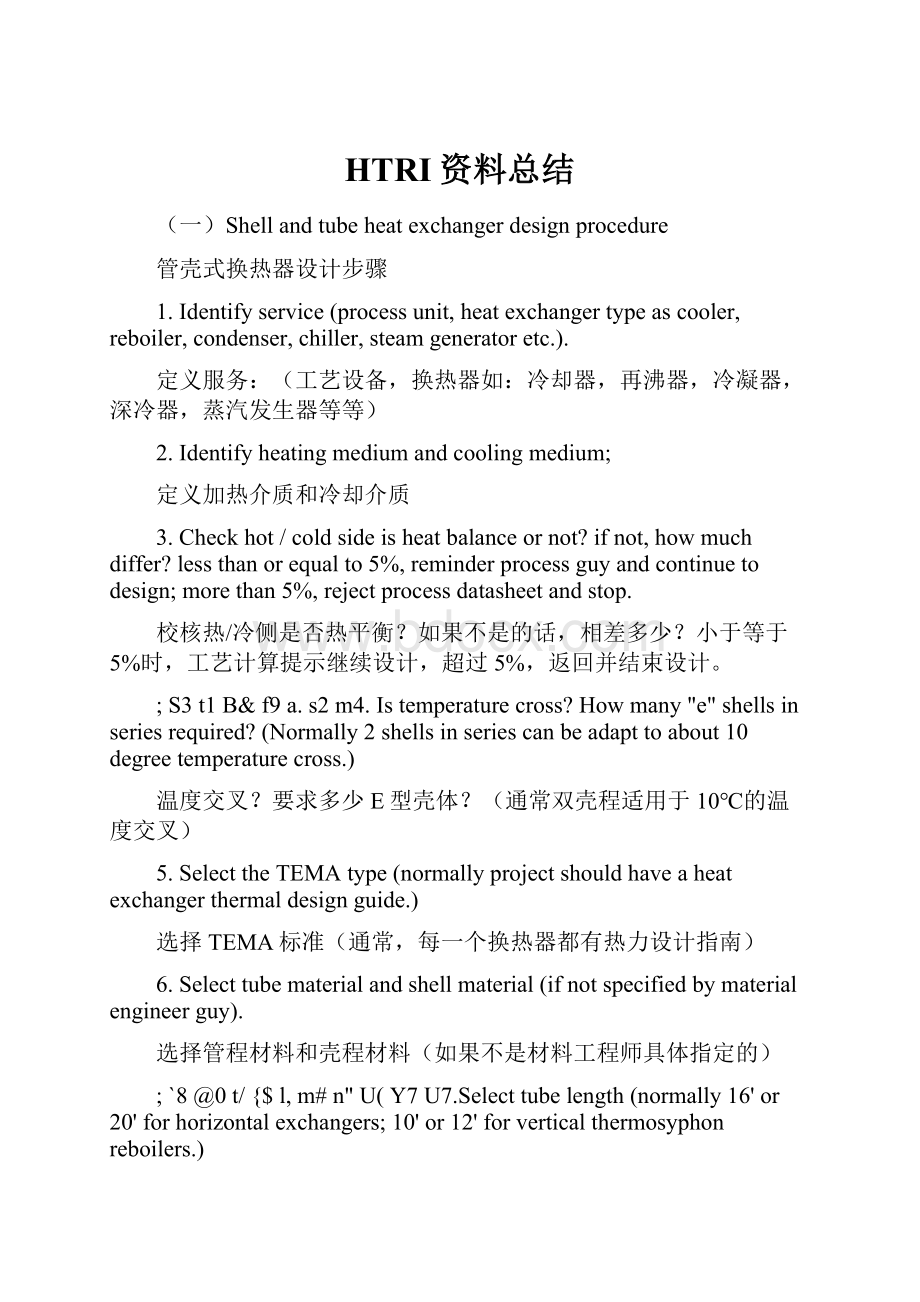 HTRI资料总结.docx
HTRI资料总结.docx
- 文档编号:25009034
- 上传时间:2023-06-03
- 格式:DOCX
- 页数:44
- 大小:62.65KB
HTRI资料总结.docx
《HTRI资料总结.docx》由会员分享,可在线阅读,更多相关《HTRI资料总结.docx(44页珍藏版)》请在冰豆网上搜索。

HTRI资料总结
(一)Shellandtubeheatexchangerdesignprocedure
管壳式换热器设计步骤
1.Identifyservice(processunit,heatexchangertypeascooler,reboiler,condenser,chiller,steamgeneratoretc.).
定义服务:
(工艺设备,换热器如:
冷却器,再沸器,冷凝器,深冷器,蒸汽发生器等等)
2.Identifyheatingmediumandcoolingmedium;
定义加热介质和冷却介质
3.Checkhot/coldsideisheatbalanceornot?
ifnot,howmuchdiffer?
lessthanorequalto5%,reminderprocessguyandcontinuetodesign;morethan5%,rejectprocessdatasheetandstop.
校核热/冷侧是否热平衡?
如果不是的话,相差多少?
小于等于5%时,工艺计算提示继续设计,超过5%,返回并结束设计。
;S3t1B&f9a.s2m4.Istemperaturecross?
Howmany"e"shellsinseriesrequired?
(Normally2shellsinseriescanbeadapttoabout10degreetemperaturecross.)
温度交叉?
要求多少E型壳体?
(通常双壳程适用于10℃的温度交叉)
5.SelecttheTEMAtype(normallyprojectshouldhaveaheatexchangerthermaldesignguide.)
选择TEMA标准(通常,每一个换热器都有热力设计指南)
6.Selecttubematerialandshellmaterial(ifnotspecifiedbymaterialengineerguy).
选择管程材料和壳程材料(如果不是材料工程师具体指定的)
;`8@0t/{$l,m#n"U(Y7U7.Selecttubelength(normally16'or20'forhorizontalexchangers;10'or12'forverticalthermosyphonreboilers.)
选择换热管长度(通常水平布置换热器用16’或者20’,垂直热虹吸再沸器用10’和12’)
)l#d/c C;o!
r7i'| y&e8.Selectthestartshellid,numberoftubesandnumberoftubepasses.
选择壳体内径,换热管数量和管程数
%V-r#P*^1_(B"_9.Selectbaffletype,orientation,cutandspacing
选择折流板形式,方向,切口和间距
10.Determinenozzlesizeandlocation
选择接管尺寸和位置
:
}7|*q4e;D0P,R5p11.Firsttry,adjustdesignparameters
首次调试,调整设计参数
(二)Topic:
thermaldesignbyHTRI
#S1_1[1e:
p1K主题:
HTRI热力设计
Designparameters(suitabletoHTRI)设计参数(适用于HTRI)
ShellI.D,Tubelength,TubeOD,Tubepitch,Tubecount,Tubepass,Baffletype,Cutandspacing,Flowrateofhot&coldfluid
9u0d*f3v){4X壳程内径,管长,管外径,管间距,管数量,管程数,折流板类型、切口形式以及间距,冷热流体的流速。
#|1I.w0^%L3O8\6l6IDifferentpersonruns,getdifferentresults. (运算结果因人而异)
$\2f+V7}9d;Aa)Differentbackground 不同的背景材料
b)Personnelconscious个人意识
c)HowmuchknowaboutHTRIprograms对HTRI的认知深浅
.N.?
"n4I7F"F4r"u;Nd)Confidencelevel 把握程度
3K:
Y/T2_1i&ke)Mistakes 犯错
HTRICaseMode:
Rating,Simulation,Design HTRI案例、模拟、设计
ShellGeometry:
Type 壳程几何结构
BaffleGeometry:
Type-none,singlesegmental(单弓形),doublesegmental(双弓形),NTIW(notubeinwindow)窗口不排管,Rod折流杆,Helical螺旋折流板,DoubleHelix双螺旋,EMfull蛋框式全折流板,EMSegmental蛋框式部分折流板.
Orientation方向:
Horizontal,vertical,45degree水平、竖直、45°倾斜
0G-P9~;]'p9t-f9^Cut-min.max. Spacing-inlet,outlet,min,max.
/I*K)A)Q3v3|.Q6A2^,y2oTubeGeometry:
lowfin,longitudinalfin,baretube,winlandGEWAKS.低翅片、纵向肋片、光管、维兰德GEWA-KS管
6V8O0H%A.r&W1DFinGeometry:
Seedatabankormanualinput;见数据库和操作手册
ReboilerData:
ThermosiphonReboiler,kettletypereboiler,requiredliquidhead,inletpressurelocation,reboilerpipingsetting.
%R6\-Y1K6a!
]2m重沸器数据:
热虹吸重沸器,釜式重沸器、所需液柱压力、进口压力,重沸器配管
:
c6W-p*X#\6w2b&BTubepass,Passlane
R(u7N/]&kBaffleGeometry:
DoubleSegmental,overlaptuberows;Variablebaffle-upto5differentspacing;
4j6u.R#z$g-}折流板结构:
双弓形,
Clearance:
BlockA,F,Estream;settingsealstrip/rod;bundle-to-shellclearance,baffle-to-tubeclearance,nozzleinlet/outleheight;
间隙:
A,F,E流路;设计密封条和密封杆;管束和壳体间的间隙,折流板和换热管的间隙,进出口接管高度:
Nozzle:
inlet/outlet&vent/drain 接管:
进出口和排气管、排水管
DistributionBelts
Impingementdevice:
rod/plate
防冲装置:
防冲杆/防冲板
9{*j({4S7Q7?
Optional:
DoubleTubesheet,ExpansionJoint,FloatingHeadSupportPlate,FullSupportatU-bend,inlet/outletpartialsupport;
;X!
e-[9b*E0X+S双管板、膨胀节、浮头式换热器支撑板、U形管弯管处加全支撑,管子进口/出口段加部分支撑。
(三-1)&k%V#i&z$u$J*p)T6eComplywithASMEcodeduringearlydesignstages
起步设计阶段遵从ASME标准
CompliancewiththeASMECodeduringthethermaldesignphaseassuresthatthefinalshell-and-tubeheat-exchangerdesignisaccurateandminimizeslosttimeandlaborformakingrevisionslater.热力设计阶段遵从ASME标准能确保管壳式换热器的最终设计的准确性,将浪费的时间缩至最低,为后期版本的修改减少工作强度。
;J,c!
y f&yTheclassicaldivisionbetweenthermaldesignengineersandmechanicaldesignengineersisbecomingblurred.Toolsarenowavailablethatenablethedesignengineertoperformanintegratedthermal/mechanicaldesigncalculation.热工计算工程师和设备设计工程师之间传统的划分正在变得模糊。
现在软件的可行性使得设计工程师解决热力和设备设计整套的计算。
%W)c-I7\&X)K3i!
nTraditionally,theprocessengineerwoulddesigntheheatexchangertomeetprocessrequirementsandthentransferthebasicexchangergeometrytoamechanicalengineerfordetailedmechanicaldesign.Themechanicalengineerwouldapplyconstructioncoderules,suchasthoseestablishedbyASMEandbytheTubularExchangerManufacturersAssociation(TEMA),andcheckforoverstressconditionscausedbythermalandotherstresses(longitudinal,compressive,etc.).Inmanycases,achangewasinitiatedbythemechanicalengineerthatwouldaffectthethermaldesign.Ifthemechanicalengineerrecognizedthis,thechangewouldbesentbacktotheprocessengineerforreview.This"work-inprogress"transferwouldberepeatedseveraltimes,wastingtimeandmoneywitheachtransfer.
一般来讲,工艺工程师设计换热器来满足工艺需要,然后提出基本的换热器结构给设备工程师,设备工程师完成详细的设备设计。
设备工程师将按照结构标准,比如那些已经实施的ASME标准和TEMA标准。
校核由于热应力以及其他应力(轴向应力、压缩应力等等)。
在许多例子中。
设备工程师的一个变动将影响到热力设计。
如果设备工程师认识到这点,这个变动得反馈给工艺工程师以求审核。
这样的工作过程的流转将会被重复好几次。
每一次流转都会费时费钱。
Withrecentimprovementsincomputerizeddesigntools,wenowhavetheabilitytodoa"once-through"thermalandmechanicaldesign,resultinginsignificantcostsavings.Aprojectengineerwiththeappropriatetoolscannowoverseethedesignprocessfromthermaldesigntomechanicaldesignwithoutcostlyback-and-forthmovementofdata.Thisprocedurecanalsobeextendedtovendors,therebysavingasignificantamountoftimesending,receiving,checking,andre-sendingdesigndata.
随着进来设计工具计算机化的改进,我们现在有能力做一个一次性就能通过的热力和机械计算。
而且成本显著的节约。
恰当的利用工具项目工程师能够对热力设计到机械设计整个流程进行监督,而不会造成高昂代价的前后反反复复的数据变动。
这个程序也可以扩展到供应商,从而节省大量用来发送,接收,检查的时间以及设计修改数据发送的时间。
Shell-and-tubeequipmentdesign 管壳式换热器的设计
4?
']0l$W:
s6B(_7a$LAsuccessfulshell-and-tubeheat-exchangerdesignincludesmanyaspects:
thermaldesign,mechanicaldesign,externalpipingloads,seismicloads,windloads,supportdesign,costestimation,drawinggeneration,andsoon.TheASMECode(aswellasotherconstructioncodes,suchasAD-Merkblatter[Germany],CodeFrancaisdeConstructiondesAppareilsaPression(CODAP)[France],andBS5500[U.K])playsanimportantroleinthecompletionofmanyoftheseanalyses.
8{,Q1f.}-Q一个成功的管壳式换热器设计包括许多方面:
热力设计。
机械设计,外部的管道配置,地震载荷,风载荷,支座设计,造价估计,生成图纸等等。
ASME标准(和其他的建造标准一样,比如德国的AD-Merkblatter标准,法国的CODAP标准,英国的BS5500)在许多完成分析中起着重要的作用)
/~)G3U [1s#lManystudieshavebeenconductedonthethermaloptimizationofheatexchangers.Forinstance,SteinMeyersuggeststhatthereareover500publicationsonthesubjectofheat-exchangeroptimization
(1).However,trueoptimizationnotonlyencompassesthethermaldesignportion,butalsomechanicaldesign.Inselectinganoptimumheatexchangerdesignforaparticularservice,manyissuesneedtobeconsidered,includingthefollowing.:
e3{.w+\!
n9S'h
对换热器的换热优化已经做了很多的研究,比如SteinMeyer说已经有超过500部以换热器优化为主题的出版物。
然而,真正的优化不仅包括热力设计部分,还包括了机械设计。
在为一个特定条件选择一个最佳的换热器设计,很多问题需要考虑,包括以下内容:
Geometry:
Thebestconfigurationforagivenprocessissometimesdifficulttoselect.Forexample,adistillationcolumnreboilercanhaveeitherforcedcirculation(usingapump)ornaturalcirculation(wherethefluiddensityisthedrivingforce),andwithinthesetwocategories,thereboilercanbehorizontalorvertical,withorwithoutaremovablebundle,andsoon.
)B)n7C8c&D%i结构:
给定工艺的最佳结构置,有时难以选用。
例如,蒸馏塔再沸器要么强制循环(用泵)要么自然循环(流体的密度是动力),并在这两者之中,再沸器可水平也可垂直,还有和蒸馏塔是可拆卸装配还是固定装配,等等。
Vesselshapesalsocontributesignificantlytothecostoftheunit.Ingeneral,flatcomponents(e.g.,aflathead)willbeseveraltimesthickerthancurvedones(e.g.,aformedhead).Therefore,unlesstherearereasonstospecifyflatcomponents(suchasforeasieraccesstointernals),itisalwaysbettertospecifycurvedones
(2).
)x*X4g:
x2n&k4W+G容器的形状也有助于控制成本。
在一般情况下,平面部件(例如,一个平封头)比弧形的(例如,成型封头)要厚数倍。
因此,除非有原因才使用平面部件(如更容易地进入到设备内部),弧形封头一直是更好的选择。
2R2W-`.G#^2l)A#v)w0OMaintenance:
Itisimportanttoconsidercostreductionsthroughoutthelifeoftheequipment.Forexample,easeofmaintenanceisveryimportantinhigh-foulingenvironmentswherefrequentcleaningisrequired.Foulingcanoftenbeminimizedbymaintaininghighfluidvelocitiesandavoidingstagnantfluidregimes.Otherconsiderationsincludetheselectionofthemostappropriatemethodforcleaning(chemicalormechanical,off-lineoron-line,etc.)andestablishingwhetherthetubebundleneedstoberemovedtobeproperlycleaned(3).
8Q2j#F!
S3j%M7z维护:
考虑整个设备的使用寿命来降低造价那是相当重要的。
比如,在高污染介质中频繁清洗对于维护是非常重要的的。
污垢往往可以最小化而能保持高流速和避免流体停滞的现象。
其他考虑因素包括选择最合适的方法进行清洗(化学或机械,停车状态或正常运行状态,等等),并确定管束有无必要抽出清洗。
Vibration:
Vibrationorexcessivevelocitycanoccureveninanexchangerthathasbeendesignedforoptimumoperationandmaintainability.Inmanycases,thetypeofbafflingorbafflespacing(orboth),tubelayout,ortubedimensionsmayhavetobemodifiedtoavoidtheseproblems.Forexample,usingmorelongitudinalflowwilldecreasefluidvelocitiesandreducetheprobabilityofvibration.Thesechangesrequireredesigningtheunittoestablishtheoptimumprocessdesignthatalsoavoidstheseproblems.
)S0s6t;_*d3Z*_振动:
在已完成按照最优化操作和维护设计的换热器中可能会出现振动或者过高的流速,在许多情况下,只需改动折流板或者折流板间距(或两者),换热管排布,或者管间距的形式就能避免这些问题。
例如更多的纵向流动,降低流速,就能减少振动的可能性。
这些改变,需要重新设计以确定最佳的工艺设计从而避免这些问题。
2x)|$W#^;d*p1m$H4G2EErosion-corrosion:
Erosion-corrosioncandecreasetheequipment'soperationallife.Onemethodtoavoidexcessiveerosionistomaintainfluidvelocitiesbelowanallowablemaximum.Erosioneffectsarealsoimportantincorrosionchemistry.Changesinoxy
- 配套讲稿:
如PPT文件的首页显示word图标,表示该PPT已包含配套word讲稿。双击word图标可打开word文档。
- 特殊限制:
部分文档作品中含有的国旗、国徽等图片,仅作为作品整体效果示例展示,禁止商用。设计者仅对作品中独创性部分享有著作权。
- 关 键 词:
- HTRI 资料 总结
 冰豆网所有资源均是用户自行上传分享,仅供网友学习交流,未经上传用户书面授权,请勿作他用。
冰豆网所有资源均是用户自行上传分享,仅供网友学习交流,未经上传用户书面授权,请勿作他用。


 《爱和自由》读书心得15篇.docx
《爱和自由》读书心得15篇.docx
